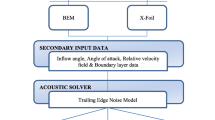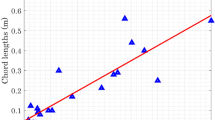Abstract
The tip loss is one of the most challenging issues in the aerodynamic performance of wind turbine blades. In this paper a simple analytical model has been proposed, based on response surface methodology, RSM to accurately predict the sectional pressure drag while the blade was oscillating in pitch in terms of the mean angle of attack, oscillation amplitude and frequency and of course, the spanwise location. In wind turbine blades, the pitching motion is usually encountered in practice and is due to the blade elastic behavior and the torsional moments. Extensive wind tunnel tests were performed on a rectangular wind turbine blade planform to construct the regression model and support the results. In this model, the combinational effects of the tip loss and induced drag as well as those associated with oscillation frequency and amplitude have been considered. The periodic upwash and downwash velocities arising from the downstroke and upstroke motions have also been included in the model in the form of a change in the effective angle of attack seen by the blade. Remarkable agreements have been achieved between the experimental results and those predicted by the present regression model in a broad range of the angles of attack and oscillation frequencies. Similar model with subtle modifications and different regression coefficients can be used for various wind turbine blade sections and planforms. No analytic model has already been proposed in the literature to predict the sectional drag for a pitching 3-D blade. Most of the existing models for tip loss work as a correction factor for CFD- or BEM-based codes.

















Similar content being viewed by others
Abbreviations
- α o :
-
Mean angle of attack
- α A :
-
Oscillation amplitude
- b :
-
Blade span
- c :
-
Chord length
- F :
-
Oscillation frequency (Hz)
- k = πfc/U ∞ :
-
Reduced frequency
- x :
-
Streamwise coordinate, measured from the leading edge
- y :
-
Spanwise coordinate, measured from the blade root
- c d :
-
Sectional drag coefficient
- c p :
-
Sectional pressure coefficient
References
Mancini, S.; Boorsma, K.; Caboni, M.; Cormier, M.; Lutz, L.; Schito, P.; Zasso, A.: Characterization of the unsteady aerodynamic response of a floating offshore wind turbine to surge motion. Wind Energy Sci. 5(4), 1713–1730 (2020)
Khlaifat, N.; Altaee, A.; Zhou, J.; Huang, Y.: A review of the key sensitive parameters on the aerodynamic performance of a horizontal wind turbine sing computational fluid dynamics modeling. AIMS Energy 8(3), 493–524 (2020)
Salimipour, E.; Yazdani, S.: Improvement of aerodynamic performance of an offshore wind turbine blade by moving surface mechanism. Ocean Eng. 195, 243–252 (2020)
Ebrahimi, A.: Atmospheric icing effects of S816 airfoil on a 600 kW wind turbine’s performance. Sci. Iran. Trans. Mech. Eng. B 25(5), 2693–2705 (2018)
Sun, J.; Sun, X.; Huang, D.: Aerodynamics of vertical-axis wind turbine with boundary layer suction-effects of suction momentum. Energy 209, 356–364 (2020)
Grinderslev, C.; Belloni, F.; Horcas, S.G.; Sørensen, N.N.: Investigations of aerodynamic drag forces during structural blade testing using high-fidelity fluid–structure interaction. Wind Energy Sci. 5, 543–560 (2019)
Mahamed, H.; Mostafa, S.; Biswas, A.Z.; Sharma, K.K.: Blade thickness effect on the aerodynamic performance of an asymmetric NACA six series blade vertical axis wind turbine in low wind speed. Int. J. Green Energy 17(2), 171–179 (2020)
Soltani, M.; Askari, F.; Sadri, V.: Roughness and turbulence effects on the aerodynamic efficiency of a wind turbine blade section. Sci. Iran. Trans. B Mech. Eng. 23(3), 927–941 (2016)
Branlard, E.; Dixon, K.; Gaunaa, M.: An improved tip-loss correction based on vortex code results. In: Proceedings of EWEA 2012—European Wind Energy Conference and Exhibition, Copenhagen, Denmark (2012)
Glauert, H.: Airplane Propellers, Division l-Aerodynamic Theory, Vol. 4. Springer, Berlin (1935)
Shen, W.Z.; Zhu, W.J.; Sørensen, J.N.: Study of tip loss corrections using CFD rotor computations. J. Phys. Conf. Ser. 555–012094(1), 1–9 (2014)
Wood, D.H.; Okulov, V.L.; Bhattacharjee, D.: Direct calculation of wind turbine tip loss. Renew. Energy 95, 269–276 (2016)
Palash, J.; Abhishek, A.: Performance prediction and fundamental understanding of small scale vertical axis wind turbine with variable amplitude blade pitching. Renew. Energy 95, 97–113 (2016)
El khchine, Y.; Sriti, M.: Tip loss factor effects on aerodynamic performances of horizontal axis wind turbine. Energy Procedia 118, 136–140 (2017)
Zhong, W.; Shen, W.Z.; Wang, T.; Li, Y.: A tip loss correction model for wind turbine aerodynamic performance prediction. Renew. Energy 147(Part 1), 223–238 (2020)
DeLoach, R.; Hill, J.S.; Tomek, W.G.: Practical applications of response surface methods in the national transonic facility (invited). In: 39th AIAA Aerospace Sciences Meeting and Exhibit, AIAA2001–0167, Reno, NV (2001)
DeLoach, R.; Micol, J.R.: Analysis of wind tunnel polar replicates using the modern design of experiments (invited). In: 27th AIAA Aerodynamic Measurement Technology and Ground Testing, Chicago, Illinois, AIAA, pp. 2010–4927 (2010)
Laurenceau, J.; Sagaut, P.: Building efficient response surfaces of aerodynamic functions with kriging and cokriging. AIAA J. 46(2), 487–493 (2008)
Khuri, A.I. (ed.): Response Surface Methodologies and Related Topics. World Scientific Publishing Co. Pte. Ltd., Singapore (2006)
Soltani, M.R.; Birjandi, A.H.; Seddighi Moorani, M.: Effect of surface contamination on the performance of a section of a wind turbine blade. Sci. Iran. Trans. B Mech. Eng. 18(3), 349–357 (2011)
Morelli, E.; Klein, V.: Aircraft System Identification: Theory and Practice. AIAA Educational Series. Sunflyte Enterprises, Williamsburg (2006)
Author information
Authors and Affiliations
Corresponding author
Rights and permissions
About this article
Cite this article
Davari, A.R., Poormand, P. An Analytical Model Including the Tip Loss Effects to Predict the Sectional Pressure Drag for a Wind Turbine Blade Oscillating in Pitch. Arab J Sci Eng 47, 8231–8241 (2022). https://doi.org/10.1007/s13369-021-06217-y
Received:
Accepted:
Published:
Issue Date:
DOI: https://doi.org/10.1007/s13369-021-06217-y




